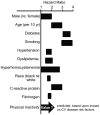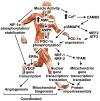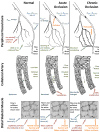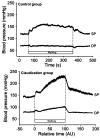Exercise training and peripheral arterial disease
- PMID: 23720270
- PMCID: PMC3767482
- DOI: 10.1002/cphy.c110065
Exercise training and peripheral arterial disease
Abstract
Peripheral arterial disease (PAD) is a common vascular disease that reduces blood flow capacity to the legs of patients. PAD leads to exercise intolerance that can progress in severity to greatly limit mobility, and in advanced cases leads to frank ischemia with pain at rest. It is estimated that 12 to 15 million people in the United States are diagnosed with PAD, with a much larger population that is undiagnosed. The presence of PAD predicts a 50% to 1500% increase in morbidity and mortality, depending on severity. Treatment of patients with PAD is limited to modification of cardiovascular disease risk factors, pharmacological intervention, surgery, and exercise therapy. Extended exercise programs that involve walking approximately five times per week, at a significant intensity that requires frequent rest periods, are most significant. Preclinical studies and virtually all clinical trials demonstrate the benefits of exercise therapy, including improved walking tolerance, modified inflammatory/hemostatic markers, enhanced vasoresponsiveness, adaptations within the limb (angiogenesis, arteriogenesis, and mitochondrial synthesis) that enhance oxygen delivery and metabolic responses, potentially delayed progression of the disease, enhanced quality of life indices, and extended longevity. A synthesis is provided as to how these adaptations can develop in the context of our current state of knowledge and events known to be orchestrated by exercise. The benefits are so compelling that exercise prescription should be an essential option presented to patients with PAD in the absence of contraindications. Obviously, selecting for a lifestyle pattern that includes enhanced physical activity prior to the advance of PAD limitations is the most desirable and beneficial.
© 2012 American Physiological Society
Figures















References
-
- Abaci A, Oguzhan A, Kahraman S, Eryol NK, Unal S, Arinc H, Ergin Effect of diabetes mellitus on formation of coronary collateral vessels. Circulation. 1999;99:2239–2242. - PubMed
-
- Abou-Khalil R, Le GF, Pallafacchina G, Valable S, Authier FJ, Rudnicki MA, Gherardi RK, Germain S, Chretien F, Sotiropoulos A, Lafuste P, Montarras D, Chazaud B. Autocrine and paracrine angiopoietin 1/Tie-2 signaling promotes muscle satellite cell self-renewal. Cell Stem Cell. 2009;5:298–309. - PMC - PubMed
-
- Abumiya T, Sasaguri T, Taba Y, Miwa Y, Miyagi M. Shear Stress Induces Expression of Vascular Endothelial Growth Factor Receptor Flk-1/KDR Through the CT-Rich Sp1 Binding Site. Arterioscler Thromb Vasc Biol. 2002;22:907–913. - PubMed
Further Reading
-
- Schaper W, Schaper J. Arteriogenesis. Boston: Kluwer Academic Publishers; 2004. pp. 1–377.
-
- Charkravarthy MV, Booth FW. Exercise. Philadelphia: Hanley & Belfus; 2003. pp. 1–326.
Publication types
MeSH terms
Grants and funding
- R01 HL084494/HL/NHLBI NIH HHS/United States
- R37 AR021617/AR/NIAMS NIH HHS/United States
- T32 AR048523/AR/NIAMS NIH HHS/United States
- R37-AR21617/AR/NIAMS NIH HHS/United States
- F32-HL10406/HL/NHLBI NIH HHS/United States
- F32 HL010406/HL/NHLBI NIH HHS/United States
- R01 HL037387/HL/NHLBI NIH HHS/United States
- F32-HL10485/HL/NHLBI NIH HHS/United States
- R01-HL084494/HL/NHLBI NIH HHS/United States
- R01-HL37387/HL/NHLBI NIH HHS/United States
- P01-HL52490/HL/NHLBI NIH HHS/United States
- T32-AR048523/AR/NIAMS NIH HHS/United States
- F32 HL010485/HL/NHLBI NIH HHS/United States
- P01 HL052490/HL/NHLBI NIH HHS/United States
LinkOut - more resources
Full Text Sources
Other Literature Sources

